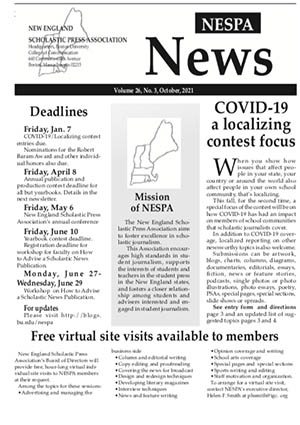Multimedia approaches change curricula
By Kait Kingman
Journalism majors have new kinds of skills to learn along with basic approaches to news gathering and presentation, said Michelle Johnson, who teaches journalism at Boston University’s College of Communication and helped to found boston.com.
“The industry is changing, journalism is changing and the way we teach is changing,” she said. “It’s not dying, it’s transforming.”
Journalists who know more than one medium and can deliver the news using new technologies are in demand right now, Johnson said in a presentation at the New England Scholastic Press Association’s 62nd annual conference Friday, April 30, at Boston University.
“If you are going to call yourself a multimedia journalist, there are a few things you need to learn,” Johnson said.
“The first is to capture and edit pictures. You have to be able to put pictures into slideshows. If you are going to put together a photo gallery, you need to decide what to include.
“You used to have a photo editor do this, but now sometimes it is up to you.”
Today, print reporters are taking pictures and using digital audio recorders, and broadcasters are blogging and writing text stories for online, she said.
“If you’re a multimedia journalist, you need to know how to shoot and edit video,” Johnson said. “Videos are hot on the web. Many photographers for newspapers shoot both video and still pictures. Students in photojournalism are now taught to do both.”
Curriculum changes include dropping tracks for print, TV and radio, Johnson said.
Journalism programs are emphasizing reporting across platforms so that all students learn to shoot and edit photos, video, audio, produce for the web — and write, Johnson said.
“In the old days, you would go out, report your story, write it and go home,” she said. “People think because we are using all this new-fangled technology, there will not be an appreciation for the basics. That’s not true.
“We still teach the basics,” she said, citing reporting and writing, photography, editing, design, the 5Ws and ethics.
“One of the key things we teach is how to create a story with a beginning, middle and end,” Johnson said. “That may seem very basic — journalism with a lead, and a middle, and a kicker at the end. But we also teach how that applies to multimedia.”
Other skills journalism schools are teaching today include blogging, conducting research using the Internet, mobile reporting and using visual data, Johnson said.
“If you really want to do multimedia journalism, I would seek out opportunities,” Johnson said.
“Reporting news as it’s happening is a great experience.”
Kait Kingman is an editor of The Villager at Westport High School in Westport, Mass.

